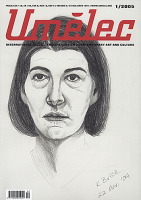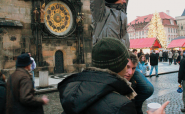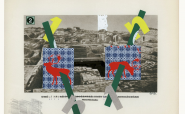| Umělec magazine 2005/1 >> Attack on the Patisserie | List of all editions. | ||||||||||||
|
|||||||||||||
Attack on the PatisserieUmělec magazine 2005/101.01.2005 Lenka Klodová | review | en cs |
|||||||||||||
|
Jan Novotný,
Cosmic Bodies Uninterested in a Burning House Serpentina cafe, Prague-Letná, December 2004 At least as far back as the 1960s, fine art has been inseparably bound by space. When he hurled molten lead into a corner, Richard Serra rendered space as an integral aspect of an art work. The peak of that era has past when monumental installations would work with entire galleries and other spaces and viewers would wander in darkness or perhaps remove their shoes at the entrance. A remaining relic, of sorts, of that significant transformation with the possibilities of fine art, is something referred to as sensitivity—a sensitivity towards space and environment in general, both socially and esthetically. Artists have an understandable need to exhibit. The reasons don’t have to be personal, they want to do something for others, to show them something. And should it be that no one invites them to exhibit for a long time, they attempt to satisfy this need themselves. At that point they exhibit everywhere—in bookstores, bars and patisseries. A combination of the above two categories is the work of Jan Novotný, which was on display at the Serpentina café-patisserie in Letná, Prague. With the artist’s developed sculptural and environmental sensitivity, the artist reacted with sensitivity to the patisserie’s pink painted walls, heavy drapery and upholstered furniture. The subject of the exhibition is an authentic product of that: the objects exhibited are patisserie decor. The artist’s concept resonates through a specific tension: nobody would dare locate such dirty decorations in the space a real patisserie (the dirtiness at issue is crafted; it is not the result of indifference or gathered dust). The artist doesn’t just express sensitivity to the specific space of the patisserie. The objects in themselves bear a sensitive message about the artist’s life, with certain realities in harmony that others might find in themselves dissonant. Novotný created the objects from the most familiar materials to him at the moment. As a film set designer, he employed things that he’s worked with for a few years already, after concluding his studies in the studio of Kurt Gebauer at the Academy of Arts, Architecture and Design in Prague. Two pink cocoons, nearly one meter in size, that hang from a wall, were fashioned from an inside-out rubber mold of a bronze relief by Vincenc Makovský. Most of the objects are in accord with the season (time sensitivity) coated with dry leaves and sprayed cobwebs—a necessary requisite of any set designer. Other objects are flat constructions using weatherworn planks, in places covered with paint parodying the candy-stripe décor and objects for dry flower arrangements in sweet shops. Stuck amid the latticework slats are occasional small, flat, painted objects, reminiscent of a fried egg. Large projection screens with various motifs – most often of fire, or a minimalist picture brushed with a swath of painted frame – are engulfed by the pungent odor of sackcloth. Although the artist may have had different intentions, for me, this small exhibition played gently and intelligently not only with the paltry space of the patisserie, but also with the state of contemporary artists today. In a none-to acrimonious manner, he has born witness to the very real position of the average artist a couple of years out of school—a reality of income, expenses and debt; he is seeking out the potential for creation in the face of that Dantesque assertion that art is nothing without the context of the art institution.
01.01.2005
Recommended articles
|
|||||||||||||








Comments
There are currently no comments.Add new comment